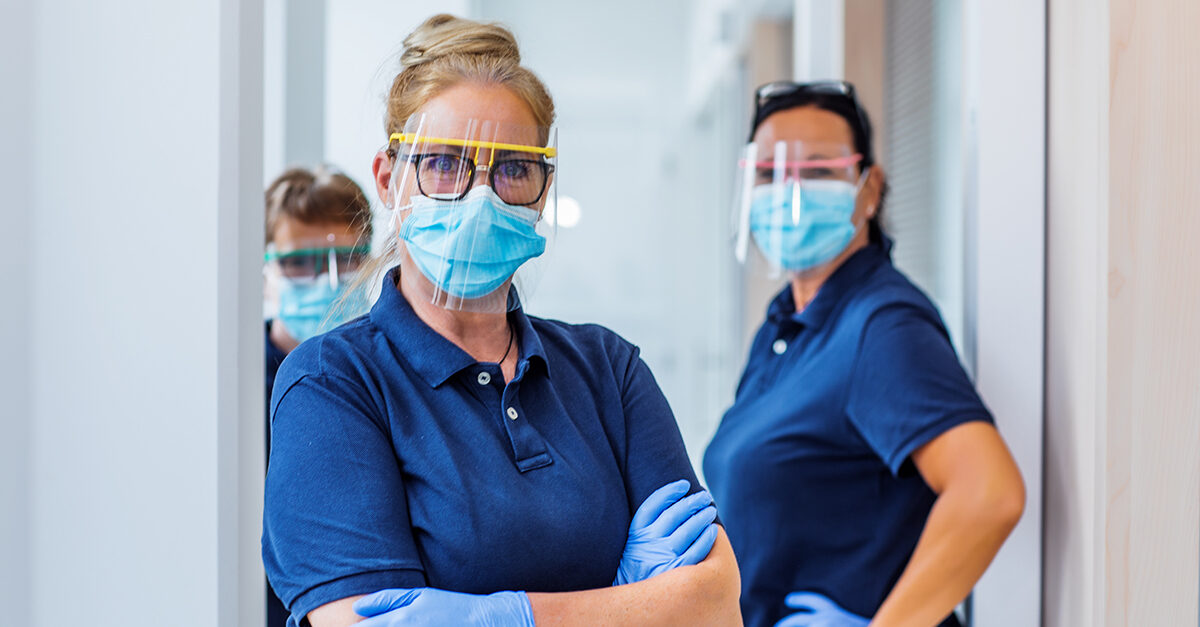Cleaning patient rooms in hospitals can put environmental services (EVS) staff at risk of contracting infectious diseases. Wearing personal protective equipment (PPE) such as eye protection, disposable gloves, N-95 respirators, and gowns can help keep workers safe, especially when cleaning the rooms of patients in quarantine. However, PPE only works well if staff use it correctly.
“Over the years and during the pandemic I’ve seen a lot of mistakes made with PPE,” said Ann Marie Pettis, president of the Association for Professionals in Infection Control and Epidemiology (APIC) and the director of infection prevention at Highland Hospital-University of Rochester Medicine, adding that she sees mistakes not only in wearing and removing PPE, but also in reusing it. “In the height of the pandemic we were doing all kinds of desperate things, but hopefully we now have a better supply,” Pettis said.
Keep it clean with eye protection
COVID-19, spread through droplets in the air, has brought about a resurgence of eye protection.
“If COVID-19 has taught us anything it’s the importance of eye protection,” Pettis said. “I hope the use of eye protection is something we will see more of, even coming out of the pandemic.”
Many workers mistakenly think that if they wear glasses they don’t need face shields or safety goggles. “There are gaps along the sides of regular glasses; you are not protected,” Pettis explained.
Besides not wearing it, another common eye protection mistake is users neglecting to clean it.
“After you take it off you need to make sure you disinfect it,” she said. “I often see people take off their face shields and just throw them down somewhere without cleaning them first. If the face shield was coughed on, now you have contaminated that surface.”
Pettis recommends wiping down eye protection with disinfectant wipes, then storing it in a clean area until its next use.
Cover your hands
Although disposable gloves are a commonly worn form of PPE, many hospital workers do not follow best practices when using them. For example, many neglect to wash their hands before donning gloves and after taking them off. “The gloves have microscopic holes; viruses can get in,” Pettis said.
As disposable gloves are available in multiple sizes, EVS staff should choose the correct size so they’re not too loose or too short. “You want to make sure you’re covering your wrists, the more skin you can cover the better,” Pettis said.
When exiting a patient room, remove and dispose of your gloves properly and don a fresh pair for the next cleaning task. Don’t keep the used gloves. “I see people spreading germs by wearing their gloves to the grocery store,” Pettis said.
Ties belong in the back
Although not as commonly worn by EVS staff, gowns may be necessary when entering a quarantine area. Gowns can be difficult to put on, especially in reaching the ties in back. Pettis said she sees many workers incorrectly wearing gowns with the ties in front.
“They complain that they are hot wearing the gowns the right way, or that it is easier to tie them with the ties in front,” Pettis said. “But wearing the gowns backward can expose you to germs.”
Masks up….not down
Face masks and respirators, such as N-95s, hanging around people’s necks and dangling from their ears has unfortunately become an everyday sight, at work and out in public. “You also see people lowering their masks to talk. That’s a big no-no,” said Pettis. “I know it can be hard to understand people when they’re wearing a mask, but constantly lowering masks can lead to contamination, as does hanging a mask on your ears or around your neck instead of discarding it.”
Pettis urges cleaning staff to forget about the methods they employed when masks were hard to come by. “During the time we were desperate for masks we had to get creative. But no more putting it in your pocket and saving it for later,” she said.
EVS staff should ensure the mask or respirator covers their nose and mouth without any gaps. Check for fit by blowing out to ensure you don’t feel a lot of air escaping from the mask. “You can perform that seal check before you enter a room,” Pettis said. “If you’re adjusting your mask constantly when you’re working that means you have a bad fit.”
Remove with care
At the end of a cleaning task or the workday, doffing your PPE shouldn’t be rushed or haphazard. “Take it off in a slow and deliberate manner, remembering to take off the dirtiest thing first,” Pettis said. The correct sequence is to remove your gloves first, then gown, eye protection, and mask last. Proper PPE removal will assure workers don’t contaminate themselves, spread germs onto surfaces, or bring infectious pathogens home to their families.



